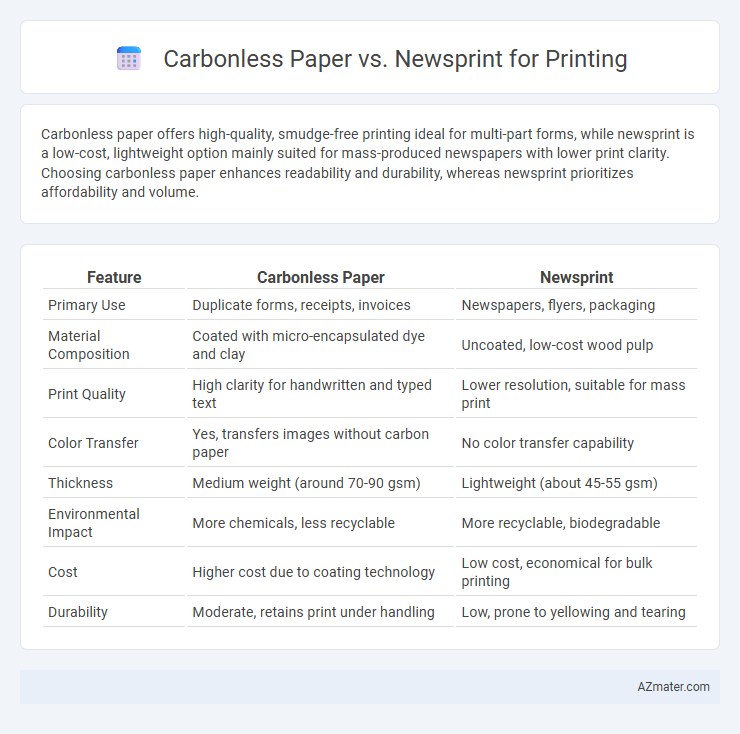Carbonless paper offers high-quality, smudge-free printing ideal for multi-part forms, while newsprint is a low-cost, lightweight option mainly suited for mass-produced newspapers with lower print clarity. Choosing carbonless paper enhances readability and durability, whereas newsprint prioritizes affordability and volume.
Table of Comparison
| Feature | Carbonless Paper | Newsprint |
|---|---|---|
| Primary Use | Duplicate forms, receipts, invoices | Newspapers, flyers, packaging |
| Material Composition | Coated with micro-encapsulated dye and clay | Uncoated, low-cost wood pulp |
| Print Quality | High clarity for handwritten and typed text | Lower resolution, suitable for mass print |
| Color Transfer | Yes, transfers images without carbon paper | No color transfer capability |
| Thickness | Medium weight (around 70-90 gsm) | Lightweight (about 45-55 gsm) |
| Environmental Impact | More chemicals, less recyclable | More recyclable, biodegradable |
| Cost | Higher cost due to coating technology | Low cost, economical for bulk printing |
| Durability | Moderate, retains print under handling | Low, prone to yellowing and tearing |
Introduction to Carbonless Paper and Newsprint
Carbonless paper is specially coated to transfer information without the need for carbon sheets, making it ideal for multi-part forms and invoices due to its clean, efficient duplication process. Newsprint is a lightweight, low-cost paper primarily used for mass printing newspapers, characterized by its high absorbency and relatively coarse texture. While carbonless paper emphasizes precision in reproduction, newsprint focuses on affordability and fast ink absorption for large-scale distribution.
Composition and Manufacturing Process
Carbonless paper consists of micro-encapsulated dye or ink chemicals coated on the back of sheets that react under pressure to create duplicate copies, while newsprint is made from a combination of wood pulp and recycled fibers with minimal processing aimed at lightweight and low-cost output. The manufacturing process of carbonless paper involves applying pressure-sensitive coatings on one or both sides and curing them to enable seamless transfer of markings, contrasting with newsprint's straightforward pulping, bleaching, and drying stages focused on brightness and printability. Both papers serve distinct printing purposes; carbonless for multi-part forms without ink ribbons and newsprint for cost-effective, high-volume newspaper production.
Print Quality Comparison
Carbonless paper offers superior print quality compared to newsprint due to its smooth surface and chemical coating that allows crisp, clear image transfer without smudging. Newsprint, made from lower-grade wood pulp, tends to absorb ink unevenly, resulting in less sharp and more faded prints. For applications requiring detailed and vibrant prints, carbonless paper provides enhanced clarity and durability unmatched by standard newsprint.
Cost Efficiency Analysis
Carbonless paper typically incurs higher costs due to specialized chemical coatings that enable instant duplicate creation without ink, making it ideal for multi-part forms but less economical for bulk printing. Newsprint, by contrast, offers a significantly lower price per unit, derived from its use of inexpensive, low-grade pulp and simpler manufacturing processes, making it cost-efficient for high-volume applications like newspapers and flyers. Businesses must weigh the cost per print against functional requirements, with newsprint providing superior cost efficiency for mass distribution and carbonless paper justifying its expense in transactional and record-keeping contexts.
Environmental Impact and Sustainability
Carbonless paper, often used for multi-part forms, contains chemical coatings that can complicate recycling and pose environmental risks due to potentially toxic compounds. Newsprint, primarily produced from recycled fibers and designed for high-speed printing, generally has a lower environmental footprint, though it still contributes to deforestation if sourced from non-sustainable wood pulp. Sustainable practices favor newsprint with certified recycled content and reductions in chemical additives, while carbonless paper requires specialized disposal to minimize ecological harm.
Common Applications in Printing
Carbonless paper is commonly used for multi-part forms, invoices, receipts, and order forms in printing due to its ability to transfer writing without carbon sheets, enhancing efficiency in business documentation. Newsprint is primarily utilized for printing newspapers, flyers, and advertisements where cost-effectiveness and high-volume production are key. Both materials serve distinct purposes: carbonless paper for duplicate records and newsprint for mass distribution of information.
Durability and Lifespan
Carbonless paper offers superior durability and a longer lifespan compared to newsprint due to its chemical-coated sheets that resist smudging and fading over time. Newsprint, made from low-cost, non-archival wood pulp, tends to yellow and degrade quickly when exposed to light and air, resulting in a significantly shorter lifespan. For applications requiring long-lasting printed documents, carbonless paper provides enhanced preservation and clarity, while newsprint is optimal for short-term, disposable print materials.
Customization and Printing Options
Carbonless paper offers extensive customization options, including multi-part forms and precise color registration suitable for invoices and receipts, enhancing business documentation efficiency. Newsprint is primarily limited to basic black-and-white or low-quality color printing, making it ideal for mass-produced newspapers but less versatile for personalized or high-detail prints. Printing on carbonless paper supports diverse technologies like laser and inkjet, whereas newsprint predominantly relies on traditional web offset printing, limiting its adaptability.
Pros and Cons of Carbonless Paper
Carbonless paper offers the major advantage of eliminating the need for carbon sheets, providing a cleaner, eco-friendlier, and efficient multi-part form solution ideal for invoices and receipts. However, it is typically more expensive than newsprint and may have limitations in longevity and archival quality due to its chemical coating. It also requires specific handling to avoid premature discoloration, making it less suitable for large-scale, low-cost printing like newspapers where newsprint remains dominant.
Pros and Cons of Newsprint
Newsprint is an affordable, lightweight paper primarily used for newspapers and mass-printing, offering high printability and fast drying times but lacks durability and fades quickly over time. Its low brightness and coarse texture limit color vibrancy and detail quality, making it less ideal for high-resolution or long-term documents. Newsprint's environmental advantage includes recyclability and biodegradability, though it typically contains lower-quality fibers compared to carbonless paper.

Infographic: Carbonless paper vs Newsprint for Printing
 azmater.com
azmater.com